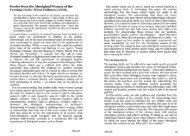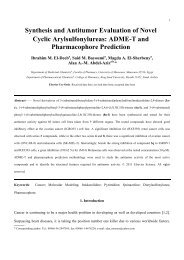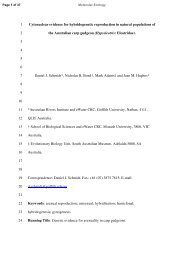Universal Primers for DNA barcoding of all Avian Species - Griffith ...
Universal Primers for DNA barcoding of all Avian Species - Griffith ...
Universal Primers for DNA barcoding of all Avian Species - Griffith ...
You also want an ePaper? Increase the reach of your titles
YUMPU automatically turns print PDFs into web optimized ePapers that Google loves.
preserved at low temperatures or in ethanol) and historical specimens (usu<strong>all</strong>y study skins or<br />
skeletons). Although many museums now collect and preserve samples from vouchered<br />
specimens <strong>for</strong> biochemical and <strong>DNA</strong> analysis (Arctander & Fjeldsa 1994; Seutin & Boag<br />
1991), this is a relatively recent practice. As a result, there are only a relatively sm<strong>all</strong> number<br />
<strong>of</strong> modern tissue samples available from vouchered specimens <strong>for</strong> New Zealand and Antarctic<br />
birds and this is likely to be the case <strong>for</strong> many regions worldwide. Furthermore, the<br />
collection <strong>of</strong> new or additional vouchered specimens is in many cases difficult, expensive and<br />
time consuming. The vast majority <strong>of</strong> historical specimens are older than 20 years in age and<br />
have not been preserved with <strong>DNA</strong> analyses in mind. Samples from these specimens typic<strong>all</strong>y<br />
produce highly degraded <strong>DNA</strong> (Lindahl 1993). The size <strong>of</strong> the <strong>DNA</strong> fragments recovered<br />
from historical samples depends on the preservation method, sample age and a number <strong>of</strong><br />
environmental factors (H<strong>of</strong>reiter et al. 2001). The degraded nature <strong>of</strong> the recovered <strong>DNA</strong><br />
from historical samples makes it difficult to amplify a fragment larger than 300-400bp in<br />
length as well as resulting in low rates <strong>of</strong> amplification (Zimmermann et al. 2008).<br />
There are a number <strong>of</strong> approaches used to tackle the problem <strong>of</strong> generating barcodes from<br />
historical museum specimens. Short or minimalist barcodes have been recovered by<br />
amplifying only a selected 100-200bp fragment <strong>of</strong> the origin<strong>all</strong>y proposed ~650bp COI<br />
region. In a number <strong>of</strong> insect genera mini-barcodes have proved to be successful in<br />
identifying almost <strong>all</strong> species (Hajibabaei et al. 2006). However, mini-barcodes show limited<br />
success compared with the full-length barcode and only work within confined taxonomic<br />
groups (Hajibabaei et al. 2006). Although potenti<strong>all</strong>y useful <strong>for</strong> the identification <strong>of</strong><br />
individual samples, this approach does not resolve the issue <strong>of</strong> having to construct an initial<br />
full-length database from which to make these identifications. Furthermore, whether it can be<br />
applied to avian species is yet to be determined.<br />
Another approach is to use a range <strong>of</strong> <strong>DNA</strong> repair enzymes. These enzymes can increase the<br />
amplification success rate by repairing some <strong>of</strong> the damage that is induced in <strong>DNA</strong> as a result<br />
<strong>of</strong> chemical treatment or aging. The most common types <strong>of</strong> <strong>DNA</strong> damage to historical and<br />
ancient <strong>DNA</strong> are oxidative and hydrolytic damage (Hoss et al. 1996). Deamination, a type <strong>of</strong><br />
hydrolytic damage common to cytosine residues, results in the replacement <strong>of</strong> cytosine with<br />
uracil, ending in C to T and G to A transitions during PCR (Evans 2007). Treatment with<br />
<strong>DNA</strong> repair enzymes can result in the reversal <strong>of</strong> most types <strong>of</strong> <strong>DNA</strong> damage leading to<br />
higher amplification success rates (Evans 2007). However, this approach has a number <strong>of</strong><br />
3





